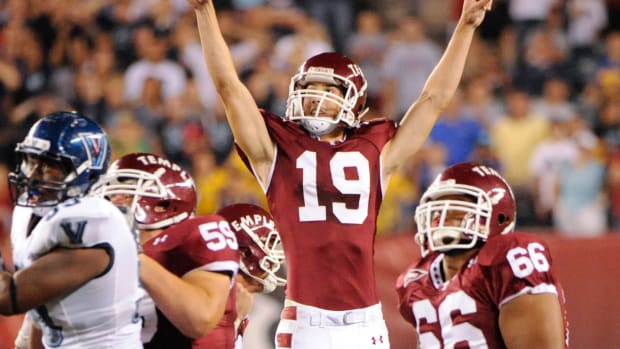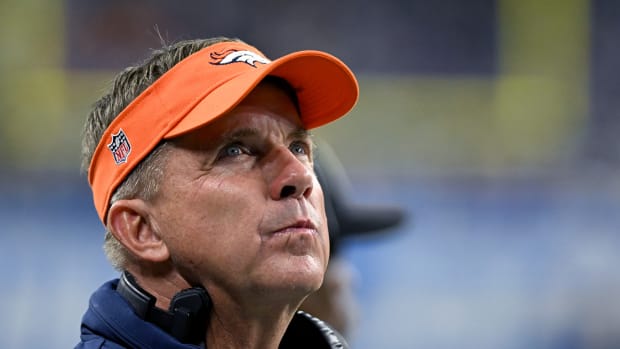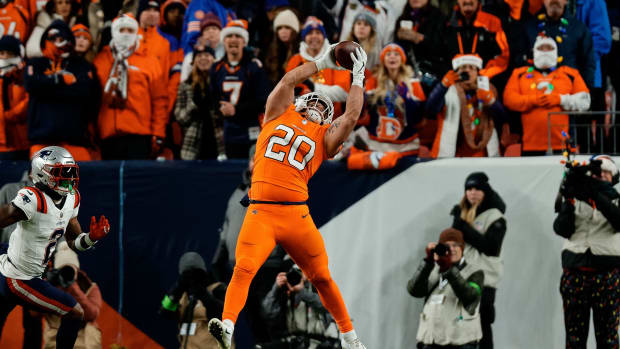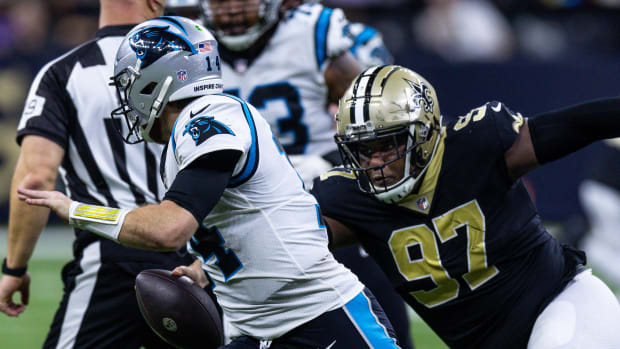Here's Why WR Should be a Top Priority for Broncos in Round One of 2020 Draft
Quarterback and offensive tackle. Offensive tackle and quarterback. Looking over the current roster structure of the Denver Broncos, it is fairly obvious which are the two biggest areas of weakness that have consistently plagued the 2019 season.
From the inability of Joe Flacco as a passer — from his pocket movement, processing, and ball placement, to the constant pressure rendered on the edges due to spotty tackle play — quarterback and offensive tackle have not been good in Denver since approximately 2015, and that has remained a constant impediment to the offense and the team over the duration of the post-Peyton Manning era.
Of course, when building a consistent contending roster in the NFL, quarterback comes first. The Broncos do have a young upside arm in Drew Lock, whom the team drafted 42nd overall in the 2019 draft. Lock had a decorated statistical career at Missouri and has the athletic tools to profile as a long-time NFL starter, but he is a relative unknown at this point.
It is almost a guarantee that he gets a chance to start at some point this season and it will be up to him if he shows enough to warrant the Broncos rolling with him in 2020, and to what degree they are ‘in’ on him, or whether the team brings in a high draft pick or veteran to compete with him or whether they use a lower draft pick to push him or a veteran that is more in the lines of a mentor rather than true a true competition.
Still, the train doesn’t leave the station until quarterback is ‘set’ in today’s NFL. On the other hand, how can a young quarterback succeed if his offensive line can’t protect him?
True, the Broncos do have some young pieces on the O-line in Dalton Risner, who is playing quite well and seems to have found a home at left guard, center in which Connor McGovern is trending up and, along with his youth and versatility, a guy that should be a high priority for the team to re-sign, Elijah Wilkinson, who looks more like a guard playing tackle but is still a cheap, young, versatile option on the line.
If that is the interior trio for the Broncos next season, they will be just fine there. Tackle, however, is still a massive albatross of an issue. With the highly-paid Ja’Wuan James playing a total of 32 snaps on the entire season and a history of injury issues, as well as the consistently penalty-laden play of Garett Bolles, tackle has remained a massive headache in Denver despite the team’s usage of priority resources on the position.
Everyone knows that offensive tackle and quarterback are issues in Denver and the team will struggle to contend until they are solved. However, they are far from the only holes on this team looking forward.
Furthermore, given that Denver is trending towards a pick in the 8-to-12 range in the upcoming draft and the gap that is growing between the likes of Tristan Wirfs and Andrew Thomas and the rest of the tackle class, the Broncos very well might have to look in a different direction to improve this roster.
It is always bad business in the NFL to force positional need over talent when picking players and building a roster. Given that Denver may miss out on the top tackles in the draft, the scarcity of quality tackles in free agency, as well as the massive unknown that is ‘what will John Elway do with the quarterback position’, it’s time to look at other areas of weakness the Broncos could consider attacking this upcoming offseason, outside the realm of quarterback and tackle.
Today’s position? Wide receiver.
State of the Position
The Broncos have found something in second-year wide receiver Courtland Sutton. Hauling in 44 receptions for 692 yards with 15.7 yards per reception, four touchdowns, and rate stats in 4.9 receptions per game, 76.9 yards per game, 65.7 catch percentage, and 10.3 yards per target, Sutton is playing like a top-15 wide receiver in the NFL, despite the Broncos' issues across the offense.
There is little doubt that Sutton has emerged as a WR1 and can be a staple of the Broncos’ passing attack as an X receiver for the foreseeable future, but who is any sort of threat opposite of Sutton? After granting Emmanuel Sanders’ request to be traded, the weapons opposite of Sutton at receiver have been limited.
Is that the fault of the scheme, the quarterback, the offensive line, or the lack of receiver talent? The truth is it is probably a mixture of all these factors, but none of the Broncos’ other wide receivers have shown any sort of dynamism that makes NFL passing attacks lethal in the current era.
DaeSean Hamilton has played 63% of the snaps since Sanders was dealt to San Francisco, which is equitable to his snap count while the Broncos still had Sanders on the roster. Despite the chance for a larger target share in the offense now that Sanders is gone, that has not been the case with Hamilton who's receiving only one single target in the last two weeks.
Hamilton is doing the dirty work, running solid routes, and blocking, but as far as being a weapon, he seems to be more of a depth piece than a player worthy of highlighting in an offense. A really good route runner, Hamilton has had issues with drops this season on top of his limitations as far as his ability to create explosive plays deep as well as after the catch. Hamilton has value as depth, but the Broncos should be looking for better talent at WR2 opposite Sutton.
The Broncos also have Tim Patrick coming off of injured reserve and set to rejoin the team soon. As a big player at 6-foot-4, with 4.47 speed at his pro day, Patrick can hopefully add more explosion to the passing attack.
However, he is a limited route runner and somewhat linear in his ability, can stretch the field with size and speed while being a willing blocker. Can he grow into the Broncos’ WR2 role? It’s possible, but more than likely he offers more value somewhere down the depth chart where a more rounded player can better compliment Sutton.
The current surprise and relative unknown for the Broncos at receiver is that of Diontae Spencer. While not receiving a bump in offensive snaps immediately following the Sanders trade, Spencer was heavily featured in the Broncos’ offense against the Browns receiving 50% of the snaps while also being targeted three times.
Much like how Taylor Gabriel was featured in Atlanta and Marquise Goodwin in San Francisco, Spencer filled the ‘speed threat’ that has become a staple of the Kyle Shanahan West Coast Offense. From stretching the seam from the slot, to pulling in the defense with pre-snap motion and threatening on jet sweeps, a true speed element is something this receiver core has desperately been missing.
Spencer might provide that long-term, but odds are he is more of a ‘this is what we currently have’ fill in as opposed to fulfilling that role for multiple seasons. The speed is there, but the ball skills, route running, and nuance required to play receiver should be questioned.
Until the offensive line and quarterback level of play is raised, just how much better can adding another dynamic wide receiver help this offense? Well, it can’t hurt.
The Candidates
Given that the NFL is using 11 personnel (3 WR sets) at a historic rate over the recent seasons, and the contracts that so-so players such as Sammy Watkins, John Brown, Adam Humphries, and Cole Beasley have received of late, there is no doubt that the receiver position's value is at or near an all-time high. Given these facts, along with how the 2020 draft class is lining up at wide receiver, this is absolutely a direction the Broncos could end up going.
From the elite talents bound for the top-15 in the draft in Alabama’s duo of Jerry Jeudy, Henry Ruggs III, and Oklahoma’s CeeDee Lamb, all three will be in play if the Broncos hold fast at pick No. 9 where they currently stand. All three are different from each other, but also different enough from Sutton to offer a massive shot in the arm to the Broncos’ offense.
Jerry Jeudy, Alabama
Jeudy has been the consensus number 1 receiver so far this season. There are some questions in regards to his pure athleticism, as well as how multiple he can be as most of his reps have come from the slot, but his ability to create separation in his routes as well as how he can move after the catch and create is special.
Despite being the consensus No. 1 receiver, there should be some questions as to how his game will translate from Alabama to the NFL. Without possessing a true ‘trump card’ trait, Jeudy might be a bit more quarterback-dependent than the other two receivers vying for the first spot. Much like how Hamilton isn’t being utilized despite his route-running savviness, the same concern might be there with Jeudy being he needs a thrower with touch and timing to be fully utilized.
This is worth noting further because there is a real chance his NFL quarterback will be worse than what he has been given at Alabama catching passes from Tua Tagovaiola. Still, given how easily Jeudy can separate with essentially any route, on top of his ability to make plays after the catch and make guys miss in space. Jeudy is a dynamic playmaker that would provide a massive shot in the arm for the offense and compliment Sutton quite well.
CeeDee Lamb, Oklahoma
Lamb may not have the route-running ability nor pure suddenness of Jeudy, but he may end up the better receiver in the NFL. Yes, Lamb does have the benefit of playing in a wide-open offense in Oklahoma under Lincoln Riley and going up against Big XII defenses, but the tape and traits are still dominant.
Possessing absolutely incredible body control and hands, the catch radius and ability to do something with poor passes is as good as any receiver in this class. Some have compared his ability there, with superb ball skills and body control, to that of DeAndre Hopkins. On top of great ball skills, Lamb is also super dynamic after the catch.
Not a true burner, Lamb’s agility, open field vision, and unwillingness to be taken down by weak tackle attempts bodes well for him at the next level. With more and more quick passes being used in the NFL, being able to do something after the catch is becoming a ‘must-have’ for receivers. With a bigger frame, better ball skills, and perhaps even better speed, Lamb has as much case for wide receiver one as Jeudy.
Outside of the massive production and traits shown by Jeudy and Lamb, they do lack perhaps the one thing that the NFL craves most in its wide receivers and something the Broncos will likely crave this offseason — speed. From their attempts to sign John Brown, trade for John Ross, and even some rumored courtship in regards to Marquise Goodwin during joint practices between the Niners and Broncos, this team is looking for a speed option.
Henry Ruggs III, Alabama
Henry Ruggs, who will likely challenge the NFL’s 40-yard dash record, could be the answer to that desire. However, just pinning Ruggs as a speed guy isn’t fair to his overall skill-set. Yes, speed is the difference maker and could have Ruggs projected as a Tyreek Hill mold in this offense.
On top of speed, Ruggs has shown a desire to block and help his teammates earn more YAC yards, is twitchy, has shown a really surprising catch radius and toughness at the catch point, and a nose for the end zone converting an absolutely absurd 26% of his total receptions for touchdowns.
Ruggs could help create spacing both horizontally with jet sweep motion and quick pass opportunities, but also create space vertically by being a man coverage killer and dictating coverage of the opponents. Much like how the Chiefs struggled against man coverage with Hill out this season, his speed is too much to leave alone and not role extra attention over to him to prevent explosive plays.
Bottom Line
Of course, there are options outside of the current big three that could make sense for Denver. Perhaps even ideally, the Broncos land one of the current consensus big two tackles in Andrew Thomas or Tristan Wirfs and can look for a wide receiver compliment day two (or even trade back up into the end of round one).
With such dynamic weapons as Colorado’s Laviska Shenault, TCU’s Jalen Reagor, Clemson’s Tee Higgins, Penn State’s K.J. Hamler, LSU’s Justin Jefferson, Oklahoma State’s Tylan Wallace, Alabama’s DeVonta Smith, Arizona State’s Devin Duvernay, amongst many other receivers, this class is as deep as it is top-heavy.
One could make the argument that Denver would be better off not going wide receiver early and picking talent from the depth and I wouldn’t argue with you. The class looks that good.
However, if Denver is on the clock with their first pick and their best player on the board is a wide receiver, they shouldn’t shy away. This team needs help where it can get it on offense and pairing another dynamic receiving threat with the emerging Courtland Sutton, the upside of Noah Fant, and the heart of the offense that is Phillip Lindsay, this team can be that much more dynamic and explosive on offense.
Quarterback and offensive line should come first, but who knows what is available when the Broncos are picking. The wide receiver position is a need for this team and given the talent of this class, is a high option for the Broncos in the upcoming season.
Follow Nick on Twitter @NickKendellMHH and @MileHighHuddle.





